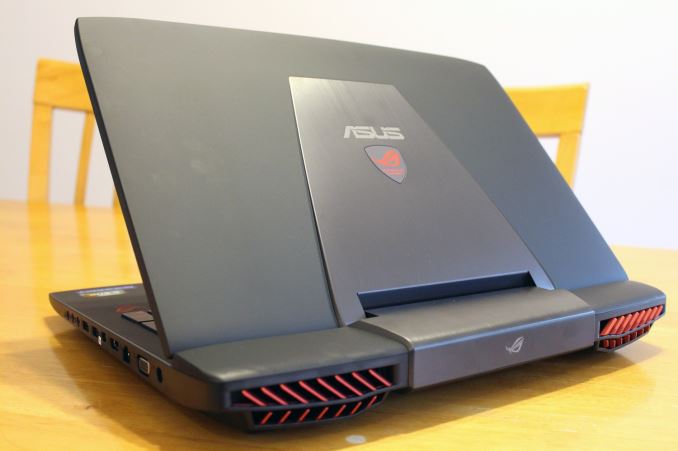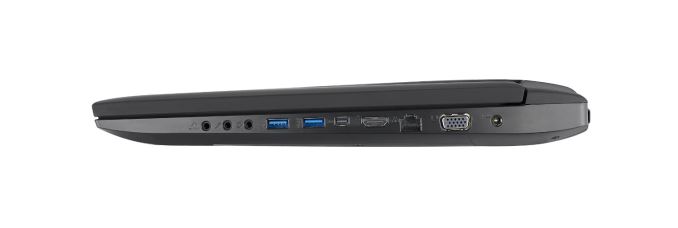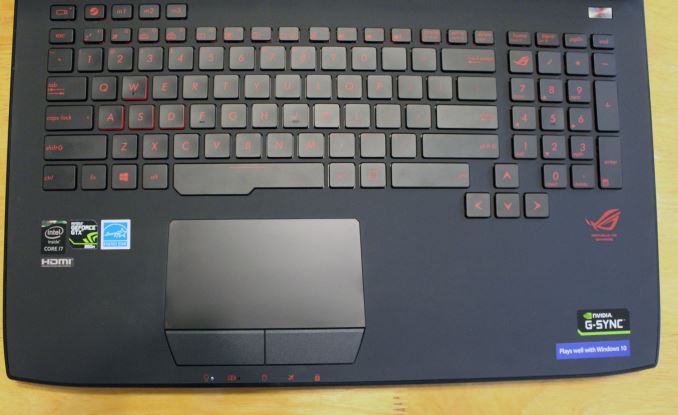The ASUS Republic of Gamers G751 Review: G-SYNC Comes To The Notebook Computer
by Brett Howse on July 29, 2015 8:30 AM ESTDesign
Notebook design decisions can make a big impact on the overall user experience. Make a device with high power components too thin, and the cooling system will have to work pretty hard to keep everything cool. Too thick, and it can be uncomfortable to use and difficult to move around.
Meanwhile on the styling side, this is really a matter of personal preference. The Pontiac Aztec crossover, which the Globe and Mail named as the ugliest car of all time, sold over 100,000 units in the USA alone during its short life. That’s not to say that the ASUS G751 is anything like the Aztec (at least in my eyes) but more to say that styling is very personal, and what one person loves another might hate.
The ASUS G751 is all matte black plastic on the interior and exterior, other than a trapezoid of brushed aluminum on the top with the ASUS and ROG logos. The ROG logo lights up in red, which is the accent color for the large rear exhaust vents, and the keyboard backlighting as well. It is nicely executed, and if you are a person who likes a bit more of a statement with your laptop, the G751 certainly delivers some of that. If you prefer an understated look, then you may have to shop elsewhere, although the goal of a device such as this is to be sat on a desk, and the more outlandish design elements such as the red exhaust vents are less noticeable.
The build quality of the G751 feels pretty solid, despite the plastic exterior. The finish does not attract fingerprints either, which is a nice bonus. On the left side is the optical drive along with two USB 3.0 ports and a SD card reader, and on the right side are two additional USB 3.0 ports, video outputs (HDMI, mini DP, and VGA), along with a 3.5mm SPDIF jack, 3.5mm microphone jack, and 3.5mm headphone jack. There is even a 1 Gbps RJ-45 port on the right side, along with the power input. The G751 has pretty much all of the bases covered.
The underside of the notebook has a couple of intake vents in the center, along with a removable cover to gain access to the DRAM and storage in order to allow for future upgrades. There’s also a small subwoofer to compliment the stereo speakers which are actually at the rear of the notebook in the exhaust vents. The four large feet are actually plastic with no rubber coating, but the large mass of the device keep it from sliding around.
Once opened up, the keyboard is front and center. As with most large notebooks, it includes full sized directional keys along with a number pad. There are also dedicated keys for game streaming (with XSplit Gamecaster pre-installed for this purpose), Steam, ROG Gaming Center, and three macro keys. The layout works pretty well, but it would have been nice for ASUS to move the up arrow over a bit in order to make room for a full sized zero key on the number pad. The keys themselves have decent travel and good feel. If anything, I would have liked a bit more key travel considering the thickness of this notebook. The keyboard backlighting looks nice in red, but the red fonts on black keys results in some pretty poor contrast when the backlighting is turned off.
The trackpad is very large, and incredibly smooth. The included software supports up to three finger navigation. There are two nice and large buttons beneath the track pad for left and right click, and you can set the trackpad to automatically be disabled when a mouse is plugged in. In front of the trackpad are five status lights for drive activity, battery charging, power status, and num lock.
The overall design of the ASUS G751 is solid, with good construction, easy access to upgrades, and pretty much every port you could ever need. Stylistically, as I said it is personal preference, but I’m not a huge fan. I feel like there is a disconnect with how the laptop looks when using it, and when you look at it from the rear, where the large red vents try to portray a stealth fighter. I do like the touch of aluminum on the top, and especially with the traditional ASUS brushed look, but it sort of feels out of place with the rear of the laptop. However, the large vents can play an important part in overall system cooling so I will re-evaluate after we take a look at how it performs.














52 Comments
View All Comments
nathanddrews - Wednesday, July 29, 2015 - link
Does Intel plan on taking advantage of the Adaptive Sync tech anytime soon? I know they use it for other things for power saving (self-refresh, etc.), but it sure seems like a golden opportunity.In the same vein - given that we know (and have known for some time) that the G-Sync module is not required if you have eDP/DP1.2a, when can we expect a shift to tech-agnostic displays? Do we have to wait for DP1.3?
DanNeely - Wednesday, July 29, 2015 - link
I know eDP/DP1.2a provides a similar feature set to G-Sync; but has nVidia actually said anything about adopting it instead of (in addition to?) their current custom hardware implementation?DanNeely - Wednesday, July 29, 2015 - link
I suppose I deserve what I get for commenting before reading the 2nd page of the article; but as long as they're requiring additional qualification work to approve a panel for GSync, there's still plenty of potential to cause trouble for cross GPU support if they wanted to.nathanddrews - Wednesday, July 29, 2015 - link
VESA's Adaptive Sync is a part of eDP and DP 1.2a+. It's there, waiting to be used. G-Sync, FreeSync, and whatever Intel does are just the names for how they utilize it.The only reason NVIDIA pursued a custom module was because no desktop monitors - at the time - included A-Sync. Screens connected via eDP can. As we move forward with newer and newer displays, we're likely to see more and more of them be A-Sync-capable, which means being able to support any variable refresh technology, whatever the marketing label is. Whether or not those displays end up as G-Sync, FreeSync, or some sort of hybrid is up to the manufacturers, I suppose. Just like with G-Sync and FreeSync displays, optimizing the display will still be important.
Ideal situation: connect monitor to computer, GPU drivers load a default profile based upon EDID for frequency range and resolution support, advanced users can tweak (under/overclock/etc.), maybe share firmware, etc. to crowd-source calibration settings. Shipping a monitor back to a manufacturer for an update is ridiculous...
lefty2 - Thursday, July 30, 2015 - link
> The only reason NVIDIA pursued a custom module was because no desktop monitors - at the time - included A-Sync.This is not true. When AMD created FreeSync the DisplayPort 1.2a monitors did not exist either, but instead of creating a propierty solution, they got FreeSync incorperated into the open standard. Nvidia could have done the same thing, but they prefer using propierty standards to lock the customers in.
nathanddrews - Thursday, July 30, 2015 - link
Interesting version of history you've created.DP1.2a display availability lagged behind G-Sync Module display availability by more than a year. If NVIDIA pursued the VESA solution, G-Sync would have been delayed alongside FreeSync. The G-Sync module was absolutely required to get a jump on the market since DP1.2 did not include the Adaptive Sync option. You may not LIKE it, but that's the how it happened.
lefty2 - Thursday, July 30, 2015 - link
DP1.2a display availability also lagged behind FreeSync... AMD just waited had to wait for them to come available (in fact they pushed the standard forward) and Nvidia could have done the same.LoganPowell - Friday, November 27, 2015 - link
ASUS does overall make fantastic computers, but I'd recommend going for the Dell Inspiron i7559-763BLK. Highly approved by many gaming enthusiasts. /Logan from http://www.consumerrunner.com/top-10-best-laptops/Creig - Thursday, July 30, 2015 - link
"additional qualification" = give us money to use the G-sync name.Shadowmaster625 - Wednesday, July 29, 2015 - link
I have a great idea. Let's build Optimus notebooks for five years, and then all the sudden build one without it! Isnt that a great frickin idea? I need to be CEO of Asus.